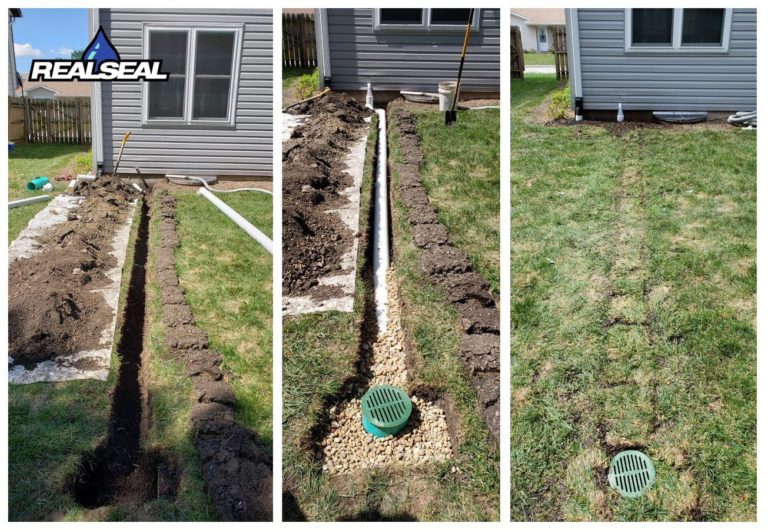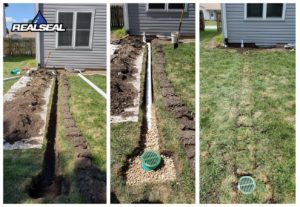You may not think so by the title of this blog, but this is a controversial issue that is contended and fought over in many villages. With 600 Gallons of water produced from 1,000 SF of roof space, and the ability for pumps to pump out 2700 gallons per hour, it is vitally important where this water goes.
Did you know that villages can make their own requirements for discharge lines and gutter extensions? Each individual village can determine how far from the house those water discharge lines should be. Problem is, they do not all agree.
I Had a Bad Experience
Not just a bad title to an autobiography, this is actually the excuse we heard from a village that required discharge lines end within 5 feet of the house!! 5 feet! At that distance, the water fully recirculates or ends next to the house. Guess where it goes from there? That’s right, into your basement as you are binging The Mandalorian. Not the kind of interruption you appreciate.
Village inspectors have a large say in how the code is written. The head inspector can influence and even change this code. In one notable city, Wilmette, there was a requirement for about 6 months that ALL gutters needed to be buried 3 feet in the ground to a drywell and then pop back up to a basin 20 ft from the house. The exorbitance! That is like putting racing suspension and tires and brakes on your mini-van. There really is no point in going that far.
The excuse? The head inspector had a bad experience as a child. His mother’s home, one time, flooded because the gutters froze and overflowed. It doesn’t even relate! We inquire as it has never been a requirement, and he said it has! You have just missed it! Ok….fast forward 6 months and we go again and the stipulation, and inspector, are gone. No explanation, but we can put the pieces together.
How Far Should It Really Be?
When we break it down, there are 3 places that a discharge line or gutter extension could be installed:
- Buried to grade
- The lines are buried just underneath the ground, and discharge to the ground via a discharge basin, even with the ground. This should be a MINIMUM 20 ft from the house to avoid putting the water in your basement. Here is a link to our How-We-Do-It Video showcasing this method.
- Tied to a Storm Sewer
- Many cities/townships will allow you to tie a gutter/discharge line into a city storm sewer. These can be found on the customer’s property, or right by the curb of the street. Need city permission to tie in.
- Tied into a Sanitary Sewer
- Ew! But yes, it is actually a Code Requirement for the City of Chicago. All discharge lines are to be tied into the combined Sanitary/Storm Sewer. Chicago is one of the last cities to have this system.
There is another option that is not mentioned above. We don’t mention it because SO many times it is installed incorrectly, and not everybody can have one.
Drywells
A drywell is basically a large basin under your yard. Water flows into the drywell and the large surface area on the bottom of the basin allows water to drain into the water table. The benefit to these is you don’t see any of the water, as it all dissipates under the ground. Some townships require drywells or a direct connection into the storm system, as they do not want any flooding in yards. There are a few things to look out for when installing a drywell, or when having a contractor come to look at one:
- They are not always possible
– We need to all caps because we have found many dry wells that are little more than a hole in the ground, further flooding the yard.
- Not everyone is qualified to install one
– You would think it is easy, but the ease of installation is what allows so many to make mistakes. The proper techniques and installation code are not researched, and the system is installed incorrectly.
- Soil tests must be done
– If you want to install a Drywell for a Discharge Line or Gutter Extensions, you will need to do a soil test. If you have clay, it’s likely you cannot do a Drywell. The whole point is or water to dissipate into the ground, so you need to ensure you have the soil to allow that to happen first!
As you can see, there are several methods of discharging water from your home. The most important thing to remember is to DISCHARGE IT FROM YOUR HOME. Any lines that end within 5 feet of the house will ONLY cause foundation damage, basement flooding, and expensive repairs for the homeowner.
Thanks for reading, and as always:
“Not Everything’s Better When Wet”
Dust mites
Dust mites are tiny bugs that grow and spread at rapid rates in a household. No matter how clean your house is, they’ll still inhabit it. They love high humidity environments, so you’ll need to use a reliable dehumidifier to dehydrate the dust mites. The humidity levels in your basement should never be above 60 percent. Dust mites may seem harmless, but they’re notorious for irritating asthma and allergy sufferers.






